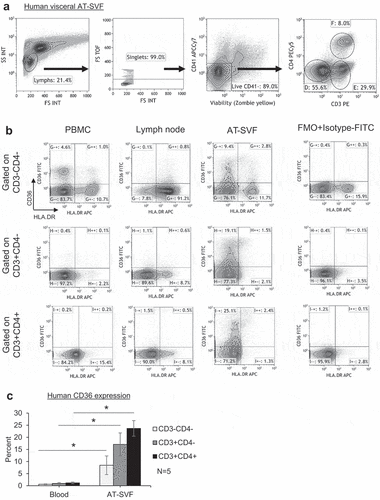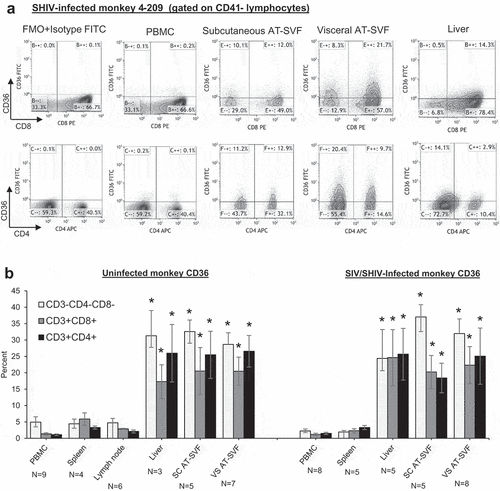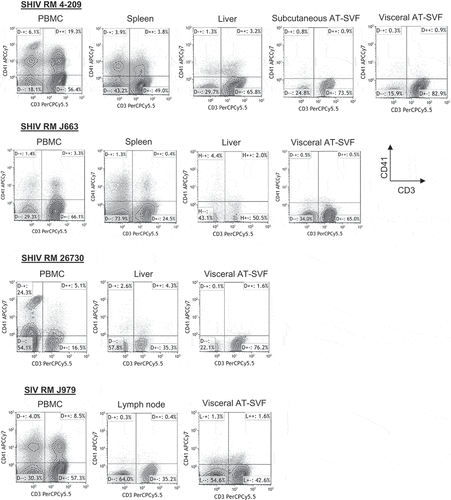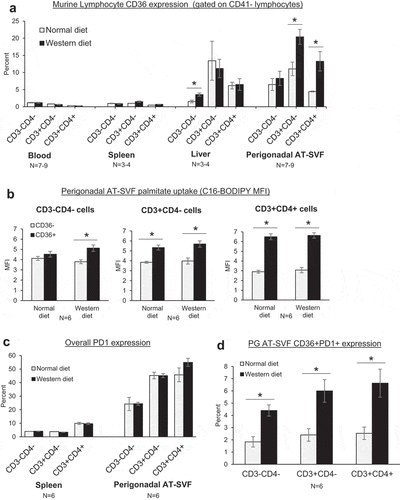Figures & data
Figure 1. CD36 expression by human adipose tissue lymphocytes. Single cells were prepared from blood, inguinal lymph node, and visceral adipose tissue stromal-vascular-fraction (AT-SVF) cells of a human donor. (a) Shown is a sample flow cytometry gating scheme of AT-SVF lymphocytes (CD3-CD4-, CD3+CD4-, and CD3+CD4+ cells, with CD41 used as a platelet discriminator in the third top dotplot from the left), and (b) HLA.DR/CD36 dotplots gated on CD3-CD4-, CD3+CD4-, and CD3+CD4+ lymphocytes of PBMC, lymph node, and AT-SVF cells, with CD36 expression based on the FMO+Isotype-FITC control. (c) Mean±sem CD36 expression by CD3-CD4-, CD3+CD4-, and CD3+CD4+ lymphocytes of human PBMC and AT-SVF cells (*p < 0.05, N = 5).

Figure 2. Upregulation of CD36 expression by rhesus monkey liver and adipose tissue SVF cells. Single cells were prepared from PBMC, spleen, lymph nodes, liver, and subcutaneous and visceral AT-SVF cells of uninfected and SIV- or SHIV-infected monkeys. CD36 expression was then examined on CD3-CD8-CD4-, CD3+CD8+, and CD3+CD4+ lymphocytes by flow cytometry. Shown in A are sample CD8/CD36 and CD4/CD36 flow cytometry dotplots (gated on live CD41- lymphocytes) of an SHIV-infected monkey, and B shows mean±sem CD36 expression (*p < 0.05 compared to PBMC, spleen, or lymph nodes; lymph nodes were not examined for infected monkeys).

Figure 3. Assessment of potential platelet interactions with T cells prepared from different tissues of monkeys. Single cells were prepared from PBMC, spleen, lymph node, liver, or subcutaneous and visceral AT-SVF cells of infected monkeys. Cells were then examined for coexpression of the CD41 platelet marker with CD3+ T cells by flow cytometry. Shown are sample CD3/CD41 dotplots of cells (gated on lymphocytes in the light scatter plot) from different tissues of four different monkeys, indicating CD3+CD41+ cells (platelet contamination of T cells) occur mostly in PBMC and spleen preparations.

Figure 4. Predominant expression of CD36 by resting T cells in adipose tissue of rhesus monkeys. Visceral AT-SVF cells were prepared from uninfected and infected monkeys. AT-SVF CD3+ T cells were then examined for expression of CD36 in conjunction with CD38, HLA.DR, or PD-1 by flow cytometry. (a) Sample CD38/CD36, HLA.DR/CD36, and PD-1/CD36 flow cytometry dotplots (gated on CD3+CD41- T cells) of three SHIV-infected monkey AT-SVF cells. (b) Mean±sem CD36 expression by CD38-/+, HLA.DR-/+, and PD-1-/+ AT-SVF CD3+ T cells (*p < 0.05 comparing CD38-, HLA.DR-, or PD-1- cells to CD38+, HLA.DR+, or PD-1+ cells).

Figure 5. CD36 expression in adipose tissue T cells during high-fat diet in mice. (a) C57BL/6J mice were fed standard chow diet (Harlan-Teklad 2920X) or 21% milk fat/34% sucrose Breslow Western-type diet (TestDiet 5TFH) for fourteen weeks. Mice were sacrificed and single cells prepared from blood, spleen, liver, and perigonadal (PG) AT-SVF cells. Cells were then examined for CD36 expression on CD3-CD4-, CD3+CD4-, and CD3+CD4+ lymphocytes (gated on live CD41- lymphocytes) by flow cytometry. Shown are mean±sem CD36 expression (*p < 0.05). (b) Fatty acid uptake by adipose tissue CD36+ lymphocytes. PG AT-SVF cells were incubated with a fluorescent palmitate analog (C16-BODIPY), washed, and examined for C16-BODIPY uptake by CD36- and CD36+ cells (gated on CD3-CD4-, CD3+CD4-, or CD3+CD4+ lymphocytes). Shown are mean±sem C16-BODIPY mean fluorescence intensities (*p < 0.05). (c–d) Upregulation of CD36+PD-1+ lymphocytes in adipose tissue during western diet. Expression of CD36 and PD-1 by CD3-CD4-, CD3+CD4-, and CD3+CD4+ lymphocytes of spleen and PG AT-SVF cells were examined by flow cytometry. Shown are mean±sem overall PD-1 expression by spleen and PG AT-SVF lymphocytes (c), and mean±sem CD36+PD-1+ double-positive lymphocytes in PG AT-SVF cells (d, *p < 0.05).

